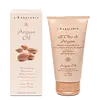What's inside
What's inside
 Key Ingredients
Key Ingredients

No key ingredients
 Benefits
Benefits

 Concerns
Concerns

 Ingredients Side-by-side
Ingredients Side-by-side

Water
Skin ConditioningPEG-80 Sorbitan Laurate
Cocamidopropyl Betaine
CleansingSodium Laureth Sulfate
CleansingDisodium Cocoamphodiacetate
CleansingSodium Chloride
MaskingPEG-150 Distearate
EmulsifyingSodium Laureth-13 Carboxylate
CleansingLauramine Oxide
CleansingButylene Glycol
HumectantPPG-26-Buteth-26
Skin ConditioningPEG-40 Hydrogenated Castor Oil
EmulsifyingApigenin
AntioxidantOleanolic Acid
Skin ConditioningBiotinoyl Tripeptide-1
Argania Spinosa Kernel Oil
EmollientCocos Nucifera Oil
MaskingPanthenol
Skin ConditioningBiotin
AntiseborrhoeicQuercus Serrata Extract
Skin ConditioningMacrocystis Pyrifera Extract
Skin ConditioningHydrolyzed Keratin
HumectantSpirulina Platensis Extract
Skin ProtectingCaffeine
Skin ConditioningCamellia Sinensis Leaf Extract
AntimicrobialTocopheryl Acetate
AntioxidantMentha Piperita Oil
MaskingNiacinamide
SmoothingPhenoxyethanol
PreservativeEthylhexylglycerin
Skin ConditioningWater, PEG-80 Sorbitan Laurate, Cocamidopropyl Betaine, Sodium Laureth Sulfate, Disodium Cocoamphodiacetate, Sodium Chloride, PEG-150 Distearate, Sodium Laureth-13 Carboxylate, Lauramine Oxide, Butylene Glycol, PPG-26-Buteth-26, PEG-40 Hydrogenated Castor Oil, Apigenin, Oleanolic Acid, Biotinoyl Tripeptide-1, Argania Spinosa Kernel Oil, Cocos Nucifera Oil, Panthenol, Biotin, Quercus Serrata Extract, Macrocystis Pyrifera Extract, Hydrolyzed Keratin, Spirulina Platensis Extract, Caffeine, Camellia Sinensis Leaf Extract, Tocopheryl Acetate, Mentha Piperita Oil, Niacinamide, Phenoxyethanol, Ethylhexylglycerin
Water
Skin ConditioningDisodium Cocoyl Glutamate
CleansingArgania Spinosa Kernel Oil
EmollientCoco-Glucoside
CleansingGlyceryl Caprate
EmollientSodium Cocoyl Wheat Amino Acids
CleansingXanthan Gum
EmulsifyingSodium Cocoyl Glutamate
CleansingArgania Spinosa Leaf Extract
Skin ConditioningHydrolyzed Sweet Almond Protein
Skin ConditioningPanthenol
Skin ConditioningGlycerin
HumectantSodium Chloride
MaskingDicaprylyl Ether
EmollientCitric Acid
BufferingParfum
MaskingPotassium Sorbate
PreservativeSodium Benzoate
MaskingWater, Disodium Cocoyl Glutamate, Argania Spinosa Kernel Oil, Coco-Glucoside, Glyceryl Caprate, Sodium Cocoyl Wheat Amino Acids, Xanthan Gum, Sodium Cocoyl Glutamate, Argania Spinosa Leaf Extract, Hydrolyzed Sweet Almond Protein, Panthenol, Glycerin, Sodium Chloride, Dicaprylyl Ether, Citric Acid, Parfum, Potassium Sorbate, Sodium Benzoate
Ingredients Explained
These ingredients are found in both products.
Ingredients higher up in an ingredient list are typically present in a larger amount.
You may know this ingredient as argan oil. Argan Oil has antioxidant, hydrating, and soothing properties.
Studies have shown argan oil can help fight again radical damage from the sun. This makes it effective at preventing hyperpigmentation.
Large amounts of vitamin E found in argan oil helps the skin retain water. Argan oil also contains fatty acids such as linoleic acid, oleic acid, and palmitic acid. It is also a good source of lipids.
Another benefit of argan oil is skin-soothing. It can help reduce inflammation-related skin symptoms.
Argan Oil is effective at regulating sebum production in pores. This can make it effective at treating hormonal acne.
Traditionally, argan oil was used for its antibacterial and antifungal properties. However, argan oil contains fatty acids that may make it not fungal-acne safe.
Argan Trees are native to Morocco.
Learn more about Argania Spinosa Kernel OilPanthenol is a common ingredient that helps hydrate and soothe the skin. It is found naturally in our skin and hair.
There are two forms of panthenol: D and L.
D-panthenol is also known as dexpanthenol. Most cosmetics use dexpanthenol or a mixture of D and L-panthenol.
Panthenol is famous due to its ability to go deeper into the skin's layers. Using this ingredient has numerous pros (and no cons):
Like hyaluronic acid, panthenol is a humectant. Humectants are able to bind and hold large amounts of water to keep skin hydrated.
This ingredient works well for wound healing. It works by increasing tissue in the wound and helps close open wounds.
Once oxidized, panthenol converts to pantothenic acid. Panthothenic acid is found in all living cells.
This ingredient is also referred to as pro-vitamin B5.
Learn more about PanthenolChances are, you eat sodium chloride every day. Sodium Chloride is also known as table salt.
This ingredient has many purposes in skincare: thickener, emulsifier, and exfoliator.
You'll most likely find this ingredient in cleansers where it is used to create a gel-like texture. As an emulsifier, it also prevents ingredients from separating.
There is much debate on whether this ingredient is comedogenic. The short answer - comedogenic ratings don't tell the whole story. Learn more about comegodenic ratings here.
The concensus about this ingredient causing acne seems to be divided. Research is needed to understand if this ingredient does cause acne.
Scrubs may use salt as the primary exfoliating ingredient.
Learn more about Sodium ChlorideWater. It's the most common cosmetic ingredient of all. You'll usually see it at the top of ingredient lists, meaning that it makes up the largest part of the product.
So why is it so popular? Water most often acts as a solvent - this means that it helps dissolve other ingredients into the formulation.
You'll also recognize water as that liquid we all need to stay alive. If you see this, drink a glass of water. Stay hydrated!
Learn more about Water